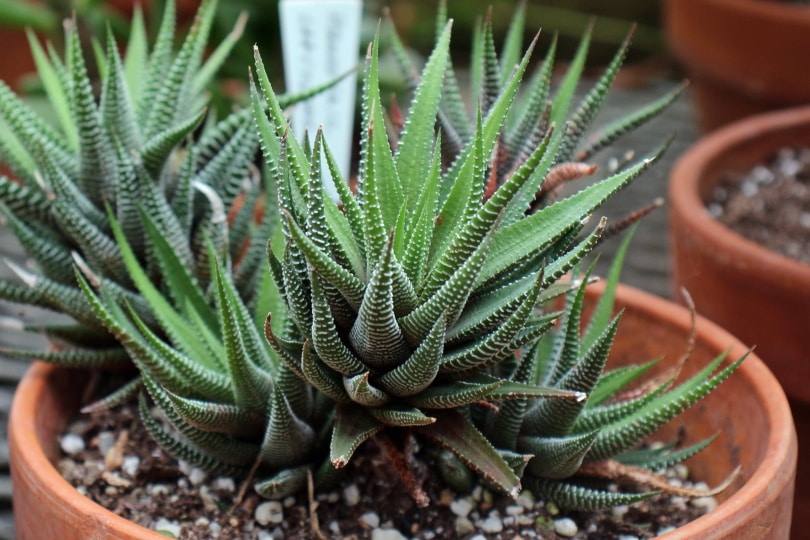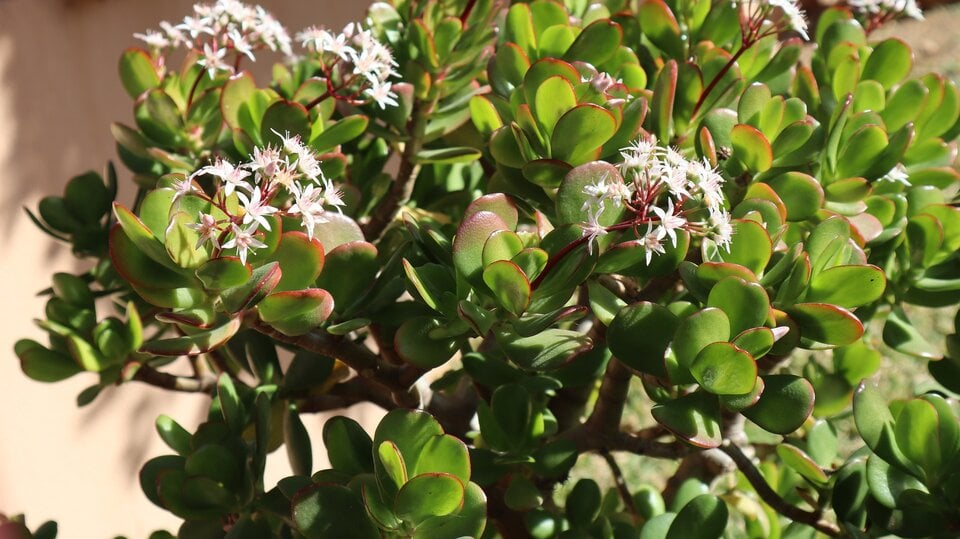
Click to Skip Ahead
Succulent plants can add lovely décor to your home. They are easy to care for and are hardy both indoors and outside. But if you have cats, you may be wondering if that succulent plant used as a centerpiece on your breakfast table is safe for your feline fur baby.
The short answer is that not all succulent plants are poisonous to cats, but a few are, so it’s important to be able to tell the difference. Read on to learn which ones are non-toxic and which ones you should steer clear of if you want to keep your cat safe.
What Are Succulent Plants?
Succulent plants have thick, fleshy leaves that store water. They can withstand dry climates because of their ability to hold water, and their low-maintenance requirement makes them popular as both indoor and outdoor plants. They look great on tabletops or a baker’s rack.

Are Cats Attracted to Succulent Plants?
Cats are naturally curious creatures, and some want to explore anything that strikes their attention. Not all cats will be attracted to a succulent. However, some may find the plant tempting and take a bite or two to examine the unknown object further. If you have a naturally curious cat that loves to explore, you must know for sure if your particular succulent plant is toxic or safe. If you cannot find conclusive data, it’s a good idea to ask your veterinarian for assurance.
The 4 Succulent Plants That Are Toxic to Cats
There are a few succulent plants that you’ll want to avoid because of their toxicity to cats.
1. Pencil Cactus (Euphorbia tirucalli)

Pencil Cactus is the first succulent plant to avoid. It belongs to a large genus with a vast amount of different species generally called spurge. Poinsettias (Euphorbia pulcherrima) are also included in this group of plants.
Many people are familiar with poinsettias for their beautiful red leaves that serve well for a Christmas décor, but you don’t want these plants around your cat. The plant contains a white milky sap that can cause drooling and vomiting if ingested, and it can also irritate the eyes, causing redness, swelling, and itchiness.
2. Jade (Crassula ovata)

This plant, previously classified as Crassula argentea, is also known as the lucky plant or money plant because it’s thought to bring financial prosperity and good luck. If your cat gets hold of this plant, however, the only financial outcome and luck you’ll see is a dent in your checkbook and bad luck for your cat. If your cat ingests this plant, common signs are incoordination, vomiting, and depression. If you suspect that your cat has gotten into a jade plant, a trip to the vet is justified.
3. Aloe Vera

This succulent plant is terrific to have around for treating minor burns and sores. For your cat, however, it’s considered mild to moderately poisonous. The aloe vera plant contains saponins and anthraquinones that can cause lethargy, diarrhea, and vomiting. This plant does not appear to be life-threatening to your cat, but you’ll still want to keep your feline pal away.
4. Kalanchoe Species

Kalanchoes form a group of plants that come from the tropics and bloom in beautiful colors. Common names are the chandelier plant, the mother of millions, and the devil’s backbone. They contain cardiac toxins known as bufadienolides, which can cause vomiting, diarrhea, and heart problems. They can cause abnormal heart rhythms if consumed in large amounts, for this reason it’s recommended to take your furball to the vet if you suspect that your cat decided to explore it.
The 4 Succulent Plants That Are Safe for Cats
There are more safe succulent plants than non-safe ones. If you love these types of plants, here is a list of safe succulent plants to have around without the worry of making your cat sick.
1. Haworthia Species

This plant, also known as the zebra cactus, has a spiky appearance similar to the aloe vera plant but without toxicity. They are easy to care for, and their green, spiky leaves and white polka dots add an elegant look to any home.
2. Hens and Chickens (Echeveria elegans)

These beautiful succulents have rose-shaped rosettes and fleshy green leaves and are easy to grow. They are ideal as either indoor or outdoor plants. They’re easy to grow and do well in rock gardens or containers. There are many different types and colors of this plant, all of which are non-toxic to cats. The circular arrangement of the primary leaves, known as rosettes, is called “hens,” and the smaller offshoots are called “chicks.”
3. Christmas Cactus (Schlumbergera bridgesii)

This safe succulent offers beauty to any area in the home. The best part is that it’s safe for your feline. It blooms around Christmas time (hence the name) and requires indirect sunlight. The bloom colors are pink, purple, red, or white, and it usually stays in bloom from November to February. It may be hard to find this plant at any other time of the year, but it’s a beautiful alternative to the poisonous poinsettia.
4. Sedum

These genus of succulents include beautiful plants used for groundcover, rock gardens, and as houseplants. They are exceptionally hardy and they are all safe to keep around cats. Some examples include burro’s tail (Sedum morganianum), ghost plant (Sedum weinbergii), and hardy baby tears (Sedum album).
Final Thoughts: How to Keep Your Cats Safe With Succulent Plants
There are many different types of succulent plants, with most of them being harmless to your feline friends. Knowing exactly what kind of succulent plant you have to ensure your cat’s safety is essential, though. You should also know this information so you can inform poison control exactly what your cat ate. When in doubt, always seek expert advice, such as your veterinarian.
Keep in mind, too, that just because a plant is considered non-toxic doesn’t mean you should allow your cat to eat them. Discouraging the behavior can eliminate a potential health issue down the road. If you already have succulent plants in your home, be sure to find out what type it is. If it’s toxic, either rehome the plant or put it somewhere your cat can’t access.
- Related read: Are Bromeliads Toxic to Cats? What You Need to Know!
Featured Image Credit: Piqsels








